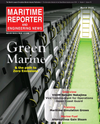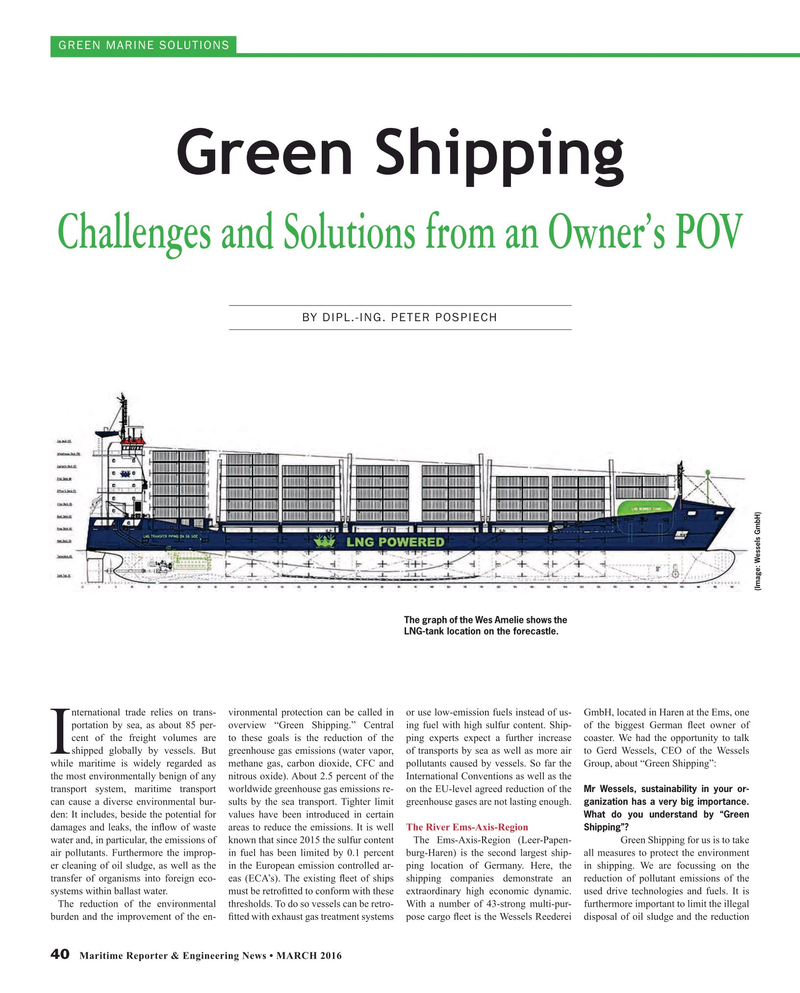
Page 40: of Maritime Reporter Magazine (March 2016)
Green Marine Technology
Read this page in Pdf, Flash or Html5 edition of March 2016 Maritime Reporter Magazine
GREEN MARINE SOLUTIONS
Green Shipping
Challenges and Solutions from an Owner’s POV
BY DIPL.-ING. PETER POSPIECH (Image: Wessels GmbH)
The graph of the Wes Amelie shows the
LNG-tank location on the forecastle. nternational trade relies on trans- vironmental protection can be called in or use low-emission fuels instead of us- GmbH, located in Haren at the Ems, one portation by sea, as about 85 per- overview “Green Shipping.” Central ing fuel with high sulfur content. Ship- of the biggest German ? eet owner of cent of the freight volumes are to these goals is the reduction of the ping experts expect a further increase coaster. We had the opportunity to talk
Ishipped globally by vessels. But greenhouse gas emissions (water vapor, of transports by sea as well as more air to Gerd Wessels, CEO of the Wessels while maritime is widely regarded as methane gas, carbon dioxide, CFC and pollutants caused by vessels. So far the Group, about “Green Shipping”: the most environmentally benign of any nitrous oxide). About 2.5 percent of the International Conventions as well as the
Mr Wessels, sustainability in your or- transport system, maritime transport worldwide greenhouse gas emissions re- on the EU-level agreed reduction of the can cause a diverse environmental bur- sults by the sea transport. Tighter limit greenhouse gases are not lasting enough.
ganization has a very big importance. den: It includes, beside the potential for values have been introduced in certain
What do you understand by “Green damages and leaks, the in? ow of waste areas to reduce the emissions. It is well The River Ems-Axis-Region
Shipping”?
water and, in particular, the emissions of known that since 2015 the sulfur content The Ems-Axis-Region (Leer-Papen- Green Shipping for us is to take air pollutants. Furthermore the improp- in fuel has been limited by 0.1 percent burg-Haren) is the second largest ship- all measures to protect the environment er cleaning of oil sludge, as well as the in the European emission controlled ar- ping location of Germany. Here, the in shipping. We are focussing on the transfer of organisms into foreign eco- eas (ECA’s). The existing ? eet of ships shipping companies demonstrate an reduction of pollutant emissions of the systems within ballast water. must be retro? tted to conform with these extraordinary high economic dynamic. used drive technologies and fuels. It is
The reduction of the environmental thresholds. To do so vessels can be retro- With a number of 43-strong multi-pur- furthermore important to limit the illegal burden and the improvement of the en- ? tted with exhaust gas treatment systems pose cargo ? eet is the Wessels Reederei disposal of oil sludge and the reduction 40 Maritime Reporter & Engineering News • MARCH 2016
MR #3 (40-51).indd 40 3/2/2016 10:29:06 AM

 39
39

 41
41
